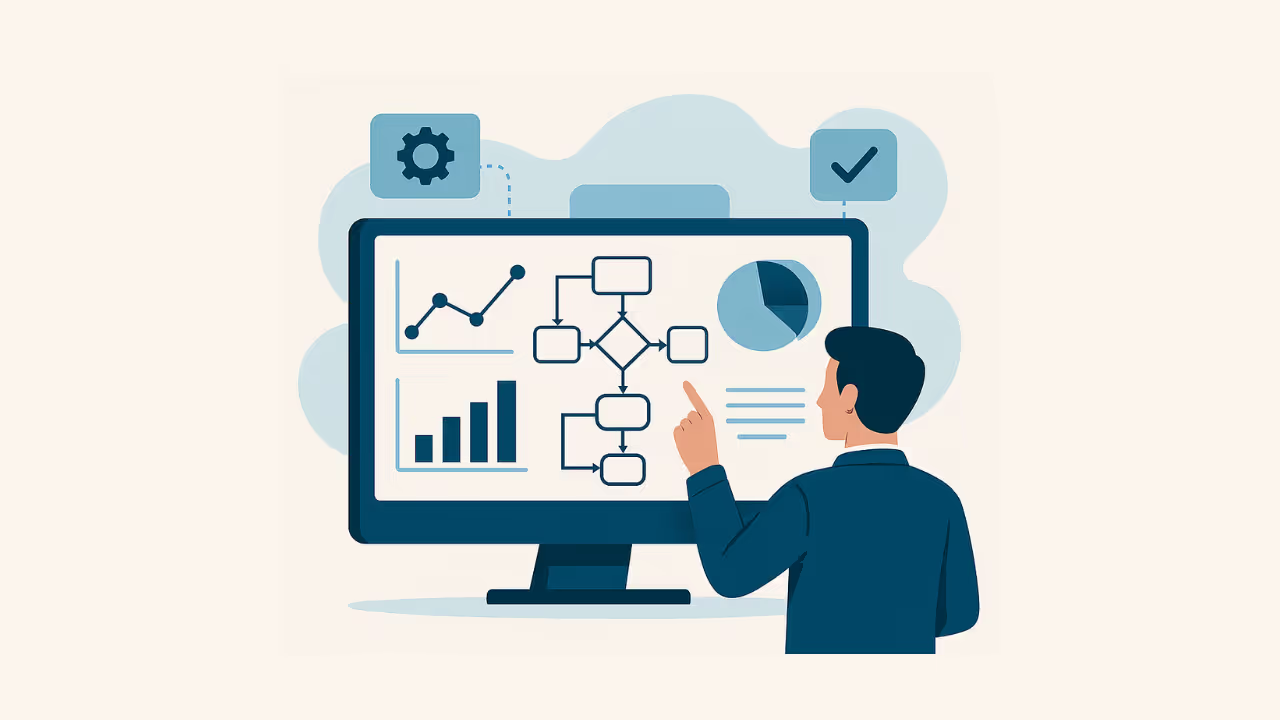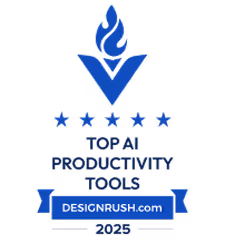AI & Analytics Glossary
Agentic Workflows in Analytics: The Next Era of Enterprise Analytics

While most enterprises still rely on static dashboards and overwhelmed data teams to drive business decisions, a revolutionary approach is transforming how enterprises interact with their data. New generative AI technology enable systems where business users can simply ask questions in plain language and receive complex analytical results in seconds, workflows where insights emerge from natural conversations rather than technical queries, and analytics platforms that understand business context and generate transparent, trustworthy answers.
This transformation is called agentic enterprise analytics, and it represents the most significant evolution in business intelligence since the invention of the dashboard. Unlike traditional BI that requires technical expertise and creates bottlenecks, agentic enterprise analytics uses specialized AI agents working in orchestrated workflows to deliver instant, actionable insights through natural language conversations.
For organizations rich in data but poor in accessible insights, agentic workflows offer a path to truly democratized enterprise analytics. This comprehensive guide explores how these intelligent systems work, why they're superior to traditional approaches, and how leading platforms enable enterprises to implement conversational analytics at scale.
What Are Agentic Enterprise Analytics Workflows and Why Do They Matter?
Agentic enterprise analytics workflows represent a fundamental paradigm shift from technical data retrieval to conversational insight generation. These systems deploy specialized AI agents that operate collaboratively, mimicking the thought process of a competent human data analyst while handling enterprise-scale complexity through natural language interactions.
The Architecture of Conversational Intelligence
Unlike traditional business intelligence that requires users to navigate complex dashboards or write SQL queries, agentic enterprise analytics workflows create intelligent conversation systems where AI agents handle complete analytical processes through natural language. Each workflow consists of specialized agents with distinct responsibilities: intent agents clarify user questions, context agents retrieve relevant business information, query agents generate appropriate code, diagnostic agents fix errors, and insights agents summarize key takeaways.
The sophistication of modern agentic enterprise analytics lies in their ability to understand business context, not just generate code. These systems incorporate company-specific terminology, data relationships, and business logic into their reasoning processes, ensuring that conversational queries produce accurate and contextually relevant results.
From Dashboards to Conversations
Traditional enterprise analytics workflows create systematic inefficiencies: business users review dashboards, identify questions requiring deeper analysis, submit requests to data teams, wait for analyst availability, receive reports days later, and often discover the analysis needs refinement. Each step introduces delays while business conditions continue evolving.
Agentic enterprise analytics workflows eliminate these bottlenecks by compressing the entire process into conversational exchanges. When a supply chain manager asks "Which suppliers are causing delivery delays?" the system immediately understands the context, generates appropriate queries, and provides detailed analysis with visualizations, all within seconds rather than days.
Why Do Traditional Dashboards and Basic AI Tools Create Enterprise Analytics Bottlenecks?
Legacy business intelligence creates systematic barriers that prevent organizations from capitalizing on their data investments. Understanding these limitations helps explain why agentic workflows represent such a significant advancement.
The Dashboard Dependency Problem
Traditional dashboards provide historical snapshots but fail to offer interactive enterprise analytics for decision-making at the moment of need. Business users must navigate multiple static interfaces, manually correlate information across systems, and still depend on technical teams for ad-hoc analysis beyond predetermined views.
The proliferation of dashboards often creates "dashboard anarchy", a graveyard of outdated, underutilized, and contradictory reports that erode trust in data rather than enabling insights. Organizations attempting to solve this with more dashboards compound the problem rather than addressing the fundamental limitation.
Basic AI Tools’ Context Problem
Simple "text-to-SQL" implementations fail in enterprise environments because they lack business context. Basic approaches retrieve only table and field names, leading to incorrect queries due to vague naming conventions, unclear relationships, and missing business logic definitions.
Most AI analytics tools acknowledge significant limitations: they cannot understand complex intent, may generate invalid syntax, and frequently reference non-existent data elements. These tools generate code but cannot debug errors, explain assumptions, or provide business-relevant insights.
The Hidden Cost of Data Bottlenecks
When ad-hoc analysis is required, organizations typically need 7+ days to transform business questions into actionable insights through traditional workflows. Highly skilled analysts spend significant time on data preparation and routine queries rather than strategic analysis, while business teams make decisions with outdated information.
This systematic inefficiency represents more than operational friction, it creates competitive disadvantages in markets where data-driven agility determines success. Agentic enterprise analytics addresses these limitations through intelligent conversation systems that democratize access to insights.
How Do Agentic Enterprise Analytics Workflows Operate End-to-End?
Agentic enterprise analytics workflows follow sophisticated operational patterns that enable conversational business intelligence. Understanding these patterns helps organizations identify implementation opportunities and design effective governance frameworks.
Phase 1: Intent Clarification
When users submit natural language queries, intent agents analyze the request for ambiguity and missing context. Rather than making assumptions, these agents ask clarifying questions or leverage historical query patterns to understand what users actually need. This prevents misinterpretation and ensures relevant results.
Phase 2: Context Retrieval and Curation
Context agents access comprehensive knowledge bases containing business terminology, data relationships, metric definitions, and industry-specific logic. Unlike basic retrieval systems, these agents actively curate relevant context, balancing comprehensiveness with precision to avoid information overload.
Phase 3: Query Generation and Validation
Query agents generate appropriate SQL or Python code based on clarified intent and curated context. The generated code incorporates business rules, handles edge cases, and follows organizational data governance policies. Diagnostic agents validate queries and identify potential errors before execution.
Phase 4: Execution and Insight Generation
Execution occurs within secure enterprise environments, ensuring sensitive data never leaves organizational boundaries. Insights agents analyze results, identify key patterns, generate appropriate visualizations, and summarize findings in business-relevant language.
Phase 5: Trust through Transparency
All analytical steps remain fully transparent, users can examine the generated code, understand reasoning processes, and provide feedback. Learning agents incorporate user corrections and preferences into future interactions, continuously improving accuracy and relevance.
What Are the Essential Components of an Agentic Enterprise Analytics Stack?
Implementing agentic enterprise analytics requires integrated technology stacks that enable AI agents to operate conversationally across enterprise environments. Understanding these components helps organizations evaluate platforms and plan implementations.
Large Language Models and Specialized Agents
Modern agentic systems leverage large language models to provide natural language understanding, contextual reasoning, and code generation capabilities. These models enable agents to process business questions, understand domain terminology, and generate technically accurate queries using conversational interfaces.
The multi-agent architecture ensures specialized expertise: intent agents excel at query clarification, context agents understand business relationships, query agents generate optimal code, and insights agents communicate results effectively.
Comprehensive Knowledge Base and Semantic Layer
Enterprise agentic systems require sophisticated knowledge bases that capture organizational data context, business logic, and domain expertise. These semantic layers include table relationships, metric definitions, business terminology, and custom calculation logic that traditional tools cannot access.
This knowledge base serves as the "business library" of the system, ensuring agents understand not just data structure but business meaning. The semantic layer bridges technical data models with business concepts, enabling accurate interpretation of conversational queries.
Enterprise Integration and Security Architecture
Agentic enterprise analytics platforms require robust integration capabilities to access enterprise systems including data warehouses, ERP platforms, and operational databases. The architecture prioritizes security through in-network processing, ensuring sensitive data remains within controlled environments.
Essential infrastructure components include:
- Secure data gateways that enable query execution within enterprise networks
- Role-based access controls that align with existing organizational permissions
Transparency and Governance Tools
Enterprise deployment requires comprehensive visibility into agent reasoning, generated queries, and analytical processes. Unlike black-box AI systems, agentic enterprise analytics platforms provide full transparency into how insights are derived, enabling validation and building user trust.
Governance frameworks include escalation procedures, feedback mechanisms, and continuous tuning capabilities that improve accuracy over time while maintaining security and compliance requirements.
How Do Organizations Measure Agentic Analytics Success?
Measuring the impact of agentic analytics requires frameworks that capture both efficiency improvements and business outcome enhancements. Leading organizations track multiple categories of metrics to assess implementation success.
Analytical Velocity Metrics
The most critical measurement involves time-to-insight reduction: the duration between asking business questions and receiving actionable answers. Successful agentic implementations typically achieve significant reduction in analysis cycle times, compressing processes that previously took days into minutes or seconds.
Organizations also track self-service rates for routine analytical processes, measuring what percentage of business questions receive immediate answers without technical team involvement. Leading implementations achieve higher self-service rates for standard business inquiries.
Business Accessibility Improvements
Agentic analytics democratizes data access by enabling non-technical users to perform sophisticated analyses independently. Organizations measure success through metrics including user adoption rates across business functions, volume of analytical questions asked and answered, and reduction in data team bottlenecks.
The cultural shift toward data curiosity represents significant value that's difficult to quantify but critically important for competitive advantage.
Operational Efficiency Gains
Traditional enterprise analytics teams spend majority time on data preparation, query writing, and routine analysis rather than strategic insights. Agentic workflows automate these tasks, enabling analysts to focus on complex problem-solving and business strategy development.
Organizations measure efficiency through cost per insight generated, analyst productivity improvements, and resource reallocation to higher-value activities.
Which Agentic Enterprise Analytics Platforms Lead the Enterprise Market?
The agentic enterprise analytics market includes several emerging platforms with different capabilities and enterprise readiness levels. Understanding platform differences helps organizations select solutions that align with their technical requirements and business objectives.
Lumi AI: The Enterprise Agentic Analytics Leader
Lumi AI leads the enterprise agentic analytics market through its sophisticated conversational interface and proven multi-agent architecture. Unlike platforms that require extensive technical configuration, Lumi AI enables business users to extract complex insights through natural language conversations, eliminating traditional barriers to data access.
Agentic Workflow Automation
Lumi AI incorporates agentic workflows that automatically monitor business metrics and alert users to significant changes or opportunities. These intelligent agents work continuously in the background, identifying anomalies, trend changes, and performance issues without human intervention.
Advanced Conversational Analytics
Lumi AI's natural language processing goes beyond simple query interpretation to understand business context, organizational terminology, and industry-specific concepts. Users can ask questions like "How has supplier performance changed since implementing our new procurement policy?" and receive detailed analyses including relevant metrics, trends, and recommendations.
The platform maintains conversation context, allowing users to ask follow-up questions and refine analyses without starting over. This conversational flow mirrors how business teams naturally explore data, making the analytics process intuitive and efficient.
Transparent AI Decision Process
Unlike black-box analytics tools, Lumi AI provides complete transparency into how each procurement insight was generated. Users can examine the underlying SQL code, review step-by-step agentic workflow execution, and trace the analytical reasoning behind every recommendation.
This transparency builds trust in AI-generated procurement recommendations and enables procurement professionals to validate insights against their operational knowledge. The system shows the exact queries executed against supplier databases, the sequential workflow steps performed by AI agents, and can request human verification at critical decision points, implementing a modern human-in-the-loop AI workflow architecture that ensures decision-makers understand and validate the foundation of their strategic choices.
Enterprise Integration Excellence
Lumi AI offers native integrations with major enterprise systems including SAP, Oracle, Microsoft Dynamics, and leading cloud data platforms. These connections provide real-time access to operational data without requiring data movement or complex ETL processes.
The platform's integration architecture supports both cloud and on-premises deployments, addressing the security and compliance requirements of large organizations across industries.
Proven Track Record: Lumi works with notable enterprises including F10 retailers, manufacturers, logistics companies and top consulting firms includeing, HelloFresh, GoBolt, Chalhoub Group, and has partnerships with Deloitte. The founding team brings deep expertise from Google, SAP, Oracle, Amazon, and other leading technology companies.
Security and Compliance Leadership
The platform meets enterprise security standards including SOC 2 compliance, GDPR requirements, and industry-specific regulations. Data processing occurs within organizational networks, ensuring sensitive information never leaves controlled environments.
Platform Comparison: Enterprise Agentic Analytics Capabilities
Transform your organization's enterprise analytics from technical complexity to conversational simplicity. Schedule a demo to see how Lumi AI's agentic workflows can democratize data access and deliver measurable competitive advantages through natural language analytics.
Frequently Asked Questions About Agentic Analytics Workflows
How do agentic analytics platforms integrate with existing enterprise data systems?
Leading platforms like Lumi AI use secure data gateways and standard connectors to integrate with enterprise systems including SAP, Oracle, Microsoft Dynamics, Snowflake, and major cloud data warehouses. All query processing occurs within controlled environments, ensuring sensitive data never leaves organizational boundaries while maintaining full conversational capabilities.
What specific metrics demonstrate ROI for agentic analytics implementations?
Key performance indicators include time-to-insight reduction, self-service analytics rates , cost per insight, and user adoption across business functions. Organizations also measure analyst productivity improvements and cultural shifts toward data-driven decision-making. Most importantly, ROI is demonstrated through direct business impact**:** revenue growth from faster opportunity identification, cost reductions from operational inefficiencies discovered, working capital optimization through inventory and cash flow insights, and risk mitigation from early issue detection.
How do business users update system behavior when requirements change?
Modern agentic platforms learn continuously from user interactions and feedback. Users can provide corrections, clarifications, and preferences that improve future responses. Advanced systems like Lumi AI incorporate organizational changes through knowledge base updates and automated learning from validated user corrections.
What safeguards ensure agentic analytics systems provide accurate insights?
Enterprise platforms implement multiple accuracy mechanisms including multi-agent validation, transparent reasoning that users can verify, comprehensive audit trails, and continuous learning from user feedback. Business context validation through semantic layers ensures queries align with organizational definitions and business logic.
Can agentic analytics handle complex multi-step business analyses?
Advanced platforms support recursive analytical workflows where agents break down complex questions into component analyses, execute multiple queries, and synthesize results into comprehensive insights. This capability enables investigation of causality, trend analysis, and multi-dimensional business questions through natural language conversations.
Related articles
The New Standard for Enterprise Analytics
Make Better, Faster Decisions.




